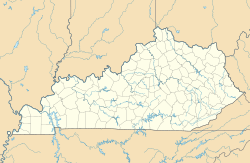Biggs site facts for kids

Group C of the Portsmouth Earthworks by Squier and Davis
|
|
| Location | South Shore, Kentucky, Greenup County, Kentucky, |
|---|---|
| Region | Greenup County, Kentucky |
| Coordinates | 38°44′8.70″N 82°54′11.92″W / 38.7357500°N 82.9033111°W |
| History | |
| Cultures | Adena culture |
| Site notes | |
| Architecture | |
| Architectural styles | earthworks |
| Responsible body: private | |
The Biggs site (also known as 15Gp8) is a very old place in Greenup County, Kentucky. It's also called the Portsmouth Earthworks Group C. This site is an archaeological site, which means it's a spot where scientists study human history. They do this by carefully digging up old objects and structures.
The Biggs site was built by the Adena culture. These were ancient people who lived in North America a very long time ago. The site was once a large area with circular walls made of earth, called embankments. It also had ditches and a cone-shaped burial mound in the center.
This site was actually part of a much bigger group of earthworks. These were known as the Portsmouth Earthworks. They stretched across the Ohio River into what is now Portsmouth, Ohio. Today, many of these old structures are gone. They were removed over time due to farming and the growth of cities.
In 1847, a scientist named E. G. Squier carefully studied and mapped the Biggs site. His detailed drawings and notes helped us learn a lot about these amazing ancient structures. His work was part of an important book called Ancient Monuments of the Mississippi Valley.
Contents
What are Earthworks?
Earthworks are large structures made by moving earth. Think of them as giant sculptures or buildings made from soil. Ancient people often built them for special reasons. These could include ceremonies, protecting their villages, or burying their dead.
Types of Earthworks
There were different kinds of earthworks. Some were long, straight walls. Others were shaped like circles, squares, or even animals. The Biggs site had circular earthworks. These were like big, round fences made of dirt.
Why were Earthworks Built?
Scientists believe the Adena people built these earthworks for important community events. The circular shapes might have been used for gatherings or religious ceremonies. The burial mounds were special places to honor and bury important people.
Who were the Adena People?
The Adena culture was a group of Native American people. They lived in parts of what is now Ohio, Kentucky, West Virginia, and Pennsylvania. They lived from about 1000 BC to 200 AD. That's over 2,000 years ago!
Adena Culture and Lifestyle
The Adena people were skilled hunters and gatherers. They also started to farm plants like squash and sunflowers. They lived in small villages and were known for their unique pottery and tools. They also created beautiful art, including carvings and ornaments.
Burial Mounds and Beliefs
A key part of the Adena culture was building burial mounds. These mounds were often cone-shaped, like the one at the Biggs site. They buried their dead with special objects. These items might have been important to the person or used in their spiritual beliefs. This tells us a lot about what they believed about life and death.
Discovering the Biggs Site
The Biggs site was first officially recorded in the mid-1800s. This was a time when many people became interested in the ancient history of North America.
The Work of Squier and Davis
E. G. Squier and E. H. Davis were two important researchers. They spent years traveling and mapping ancient earthworks across the Ohio Valley. Their book, Ancient Monuments of the Mississippi Valley, was the first major study of these sites. It helped people understand how complex and amazing these ancient structures were.
The Site Today
Today, much of the original Biggs site is gone. This is a common problem for many ancient earthworks. Over time, farming, building, and other human activities can destroy these historical places. That's why the maps and notes from early explorers like Squier are so important. They help us imagine what these sites looked like long ago.


